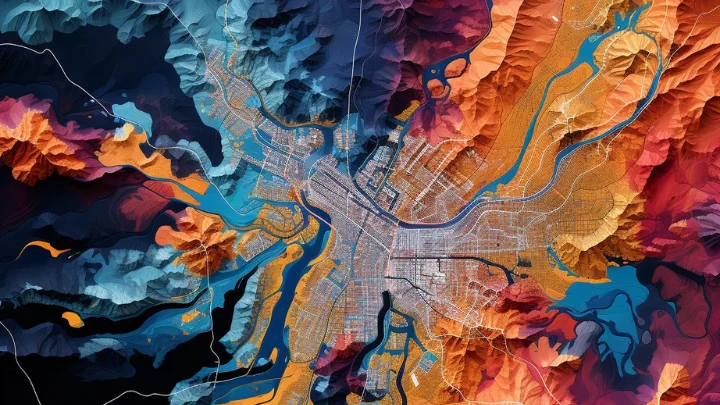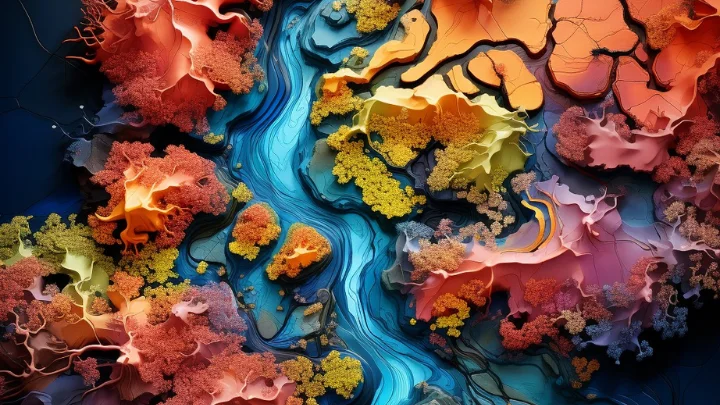This post may contain Amazon affiliate links which means, as an Amazon Associate, I may receive a small commission from purchases made through these links at no cost to you. I only recommend products I have personally used. To learn more, please see my privacy policy page.
Environmental geography focuses on the interactions between humans and their environment and how locations and conditions influence those interactions. Combining elements of physical and human geography, it seeks to understand the dynamics of environmental systems as well as the factors that influence environmental decision-making.
Key Words
- biodiversity
- climate
- conservation
- ecosystems
- fieldwork
- geographic information systems (GIS)
- natural systems
- pollution
- remote sensing
- spatial patterns
In this article, we journey through the fascinating world of environmental geography. We explore its methodologies, how it helps us understand natural and human-induced environmental changes, and look at real-world applications where environmental geography is making a discernible impact. Join me to learn why this field is not just an academic curiosity, but a critical discipline for our interconnected world. Read on…

Navigating a Complex World
In a world that’s rapidly changing—both ecologically and socially—the field of environmental geography emerges as a way to navigate these complexities. Far from being just another academic discipline, environmental geography helps us understand the relationships between the Earth’s natural systems and human activity. It not only unearths the ‘what’ and ‘where’ of phenomena but also investigates the ‘how’ and ‘why,’ offering us a multi-faceted understanding.
What sets environmental geography apart is its focus on spatial patterns. Think of it as the cartography of change. Whether it’s the sprawl of urban landscapes or the shrinking of polar ice caps, this field offers invaluable insights into how phenomena are geographically distributed. In doing so, it allows us to examine complex issues—like climate change, deforestation, and water scarcity—through a spatial lens, enabling more nuanced understanding and solutions.
But the field isn’t solely concerned with natural changes; it is equally invested in understanding human-induced transformations. These could range from the impact of agriculture on soil health to the geographic disparities in access to clean water. By evaluating the interconnectedness of human activities and natural systems, environmental geography helps us make informed decisions that are sensitive to both ecological and social realities.
Key methodologies like Geographic Information Systems (GIS), remote sensing, and good old-fashioned fieldwork play a significant role in this. These tools and techniques form the bedrock of environmental geographical analysis, providing data and visualizations that can inform everything from local zoning laws to international climate accords.

The Interdisciplinary Approach
Environmental geography is a subfield of geography that stands at the intersection of human and physical geography, offering a holistic view of how human actions and natural processes interact and influence each other across space and time. While traditional geography might focus on either human settlements or natural landscapes, environmental geography seeks to understand the relationship between the two. It’s less about compartmentalization and more about synthesis, aiming to unravel the complexities of environmental issues in a way that neither physical nor human geography can accomplish alone.
This interdisciplinary approach makes it distinct from other geographical sub-disciplines. For example, I also wrote an article on physical geography, which primarily examines natural phenomena like climate, landforms, and ecosystems. In contrast, the article I wrote on human geography focuses on societal issues like urbanization, migration, and economic disparities. Environmental geography bridges these realms, studying how human actions affect natural systems and vice versa. In doing so, it lends itself to more effective problem-solving, bringing more pieces of the puzzle to the table.
What further sets environmental geography apart is its willingness to reach beyond the boundaries of geography as a discipline. It readily incorporates insights from ecology to understand ecosystems, from sociology to investigate environmental justice, and from urban planning to explore sustainable development. Whether it’s understanding the social dimensions of natural disasters or examining the environmental impact of urban sprawl, the field brings a multi-disciplinary approach that is both broad and deep.
In summary, environmental geography is a vibrant and evolving field that blends elements of both physical and human geography while also pulling in methodologies and perspectives from other disciplines like ecology, sociology, and planning. This approach makes it an indispensable tool for grappling with the complex environmental challenges of our time.

Mapping Our Environmental Imprint: The Spatial Perspective
One of the defining features of environmental geography is its focus on spatial patterns and the distribution of both natural and human-induced phenomena across the Earth’s surface. Imagine a web of interconnected systems, from climate zones to human settlements; everything exists in a specific space, often influencing and being influenced by its neighbors. Environmental geography doesn’t just ask “What?” but also “Where?” and “Why there?”
Scale
Scale plays a significant role in shaping these spatial relationships. At a local level, environmental geography can investigate the specifics of a community’s relationship with its immediate surroundings—think localized water pollution or urban planning. At a regional scale, it can assess broader trends, such as deforestation rates across an entire biome. Then, on a
global scale, environmental geography considers phenomena that have worldwide implications, like climate change and global trade networks.
By scrutinizing patterns at these different scales, environmental geography helps us better understand, and thereby address, the complexities of natural and human-induced changes on our planet. Whether it’s mitigating the impacts of natural disasters, planning sustainable cities, or understanding the global flows of natural resources, this spatial perspective is invaluable for problem-solving in an interconnected world.
National Geographic Atlas of the World
One tool that would be exceptionally beneficial in understanding these spatial perspectives is a high-quality world atlas. An atlas not only offers a detailed look at geographical features but also includes thematic maps that provide insights into environmental, social, and economic factors.
The National Geographic Atlas (paid ad) of the World is a comprehensive resource that delves into the complexities of Earth’s systems, both natural and human-made. It provides detailed maps and thematic visuals that can aid in understanding the spatial aspects discussed in this article.

Give and Take: Human-Environment Interactions
One of the foundational tenets of environmental geography is the study of the relationship between humans and their environment. This interaction is a complex relationship; humans shape and are shaped by their surroundings in myriad ways. While geography has traditionally studied natural landscapes—mountains, rivers, and forests—environmental geography investigates the increasingly blurred line between these natural features and the transformations brought about by human activities.
We’re talking about not just the extraction of natural resources like minerals, timber, or water, but also how human practices such as agriculture, urbanization, and industrialization affect the landscape. The consequences can range from soil erosion and water pollution to more intangible impacts like changes in local climate conditions.
This is where the role of policy and governance comes into play. Environmental geographers often engage with policymakers to offer data-driven insights that can lead to more sustainable resource management strategies. Laws, zoning regulations, and international treaties are all instruments through which human-environment interactions can be governed for more sustainable outcomes.
Recommended Reading - The 6th Extinction: An Unnatural History by Elizabeth Kolbert
This book investigates the alarming rate of species extinction happening right now, which many scientists consider the sixth mass extinction event in Earth’s history. Drawing on exhaustive research and interviews, Kolbert examines how human activity is pushing the planet into uncharted territory, ecologically speaking. Given the article’s focus on environmental geography and how it helps us understand complex environmental systems, this book serves as a compelling extension of that discussion. It offers an in-depth look at one of the most urgent environmental crises of our time, making it a must-read for anyone concerned about the planet’s future.
Ready learn more about the urgent environmental challenges we face? Grab your copy of The Sixth Extinction: An Unnatural History (paid ad) and gain a profound understanding of the extinction crisis unfolding before us.

Methodologies in Environmental Geography: Tools of the Trade
In environmental geography, a range of methodologies are used to better understand the complexities of natural and human-altered landscapes.
Fieldwork: Fieldwork remains a cornerstone methodology, offering on-the-ground verification and nuanced understanding that remote sensing or GIS might not capture. Here, geographers collect data on soil quality, vegetation, air and water pollution, and much more, right from the source. This hands-on approach brings essential context and local-scale details into broader studies.
Geographic Information Systems (GIS): One of the most powerful tools is Geographic Information Systems (GIS), which allows geographers to visualize, analyze, and interpret spatial data in multiple layers. Whether mapping deforestation rates or analyzing urban sprawl, GIS provides a dynamic way to study environmental issues. Read more about GIS in this article –> Geography Meets Technology: Essential Roles of GIS
Remote Sensing: Remote sensing is another key methodology that has revolutionized the field. Using satellites, drones, or aerial photography, remote sensing enables environmental geographers to gather data on large-scale phenomena like climate change, land-use patterns, and even ocean currents. This kind of macro-level analysis is crucial for global studies and can help policymakers make informed decisions based on extensive and reliable data.
These methodologies—GIS, remote sensing, and fieldwork—are not standalone; they often complement each other, providing a comprehensive, multi-faceted understanding of environmental systems.

Natural and Anthropogenic - a Two-Sided Coin
Environmental geography serves as a bridge between understanding natural phenomena and human-induced changes in the landscape. On the one hand, the earth itself is a dynamic system—always changing and evolving. Natural changes like climate variation, sea-level rise, and erosion have been sculpting our planet for eons. Environmental geographers study these natural processes to understand their spatial distribution and long-term implications, often using sophisticated models to predict future changes.
On the other hand, the Anthropocene—a term increasingly used to describe our current epoch—points to the indelible human footprint on the planet. Urban sprawl, deforestation, pollution, and unsustainable resource extraction are just some examples of how human activities are accelerating environmental changes at an unprecedented scale. The spatial patterns of these anthropogenic changes often interact with natural processes, creating a complex web of cause and effect that is the domain of environmental geography.
What makes this field indispensable is its role in mitigation. By understanding both natural and human-driven changes, environmental geographers can suggest more sustainable practices, influence policy, and contribute to adaptive management strategies. They can advise on how to build cities that are more resilient to natural disasters or suggest where to place new green spaces for both human well-being and environmental health.

Environmental Geography in Action
The theories and methodologies of environmental geography don’t just exist in academic papers; they are actively applied to solve some of the world’s most pressing environmental issues. Below are a few instances where environmental geography has had a tangible impact:
Land Degradation in the Amazon
The deforestation of the Amazon rainforest has severe global implications, affecting biodiversity and climate. Environmental geographers have been instrumental in studying these impacts, often employing remote sensing technology to monitor changes over time. Their insights have influenced international policies aimed at sustainable forest management.
Flood Management in New Orleans
Post-Hurricane Katrina, environmental geographers used GIS (Geographical Information Systems) to assess the spatial distribution of flood risks and socio-economic vulnerabilities. This data has been pivotal in developing more effective flood management strategies.
Water Scarcity in Sub-Saharan Africa
In regions where water is scarce, like Sub-Saharan Africa, understanding the spatial distribution of this precious resource is crucial. Environmental geographers have helped local communities develop sustainable water management practices, such as rainwater harvesting and optimized irrigation systems.
Urban Planning in Singapore
Singapore’s remarkable commitment to urban greenery and sustainability owes much to the work of environmental geographers. They have assisted in the city’s planning by studying the optimal locations for green spaces, considering factors like air quality, urban heat islands, and overall well-being of the residents.
In each of these case studies, environmental geography has proven its value, not just as an academic discipline but as a practical tool for change. Its interdisciplinary approach and spatial analysis capabilities make it indispensable in the quest for a more sustainable future.

Trends and Challenges
As we navigate an increasingly complex and interconnected world, the role of environmental geography has never been more critical. The field is rapidly evolving, driven by several noteworthy trends and challenges that promise to shape its future.
First, interdisciplinary work is on the rise. The complexities of environmental problems often require a holistic approach, incorporating insights from ecology, sociology, public policy, and even economics. This multidisciplinary view enables more comprehensive solutions to intricate challenges like climate change and resource scarcity.
Technological advances, particularly in GIS and remote sensing, are another driving force. These tools allow for more precise data collection and analysis, providing a fuller picture of environmental issues at different scales. Artificial intelligence and machine learning are also being integrated, offering potential for predictive modeling and decision-making support.
Finally, the emergence of citizen science is democratizing the field. Apps and platforms enable ordinary people to contribute data and observations, effectively turning them into ‘citizen geographers.’ This not only provides scientists with more data but also engages the public in the very environmental issues that affect them.
In summary, the future of environmental geography is shaping up to be one of increasing complexity, technological integration, and public participation. By embracing these trends, the field can continue to play a vital role in addressing global environmental challenges.
Wrap Up...
As we’ve journeyed through the terrain of environmental geography, several key insights have emerged. This field is not merely an academic endeavor but a crucial tool in understanding and addressing some of the most pressing environmental challenges we face today. From mapping spatial patterns at local, regional, and global scales to scrutinizing the complexities between humans and their environment, environmental geography offers invaluable perspectives.
The blend of physical and human geography, enriched by interdisciplinary collaboration with fields like ecology, sociology, and planning, allows environmental geography to tackle issues holistically. Moreover, its methodologies—such as GIS, remote sensing, and fieldwork—equip researchers with the means to delve deep into environmental systems, providing data that can inform better policy and public awareness.
Our discussion of real-world applications and case studies further underscores this point. Whether it’s land degradation, water scarcity, or climate adaptation, environmental geographers are on the front lines, providing actionable solutions that have both immediate and long-term impacts.
Finally, we’ve looked towards the future—a future that promises increased interdisciplinary cooperation, technological advances, and public engagement through citizen science. These trends not only enhance the field itself but also increase its ability to effect meaningful change.
In a world filled with environmental challenges, the need for comprehensive, actionable insights is imperative. Environmental geography stands as a versatile and dynamic field capable of offering just that. Therefore, its significance in our environmental landscape cannot be overstated.


